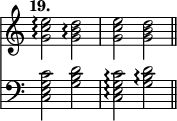while the other plays the notes all together; the correct rendering of such chords is as follows (Ex. 19).

![{ \override Score.TimeSignature #'stencil = ##f \time 4/4 << \relative g' { \stemUp \set tieWaitForNote = ##t \override TupletNumber #'stencil = ##f \times 2/3 { g32[ ~ c ~ e] ~ } <e c g>4.. \times 2/3 { g,32[ ~ b ~ d] ~ } <d b g>4.. | r16 <e c g>4.. r16 <d b g>4.. \bar "||" }
\new Staff { \clef bass \relative c' { \set tieWaitForNote = ##t \override TupletNumber #'stencil = ##f <c g e c>2 <d b g> | \stemUp c,64[ ~ e ~ g ~ c] ~ \stemDown <c g e c>4.. \stemUp \times 2/3 { g32[ ~ b ~ d] ~ } \stemDown <d b g>4.. | } } >> }](http://upload.wikimedia.org/score/p/3/p3d1ez6hwhzm7j6ujontp3azzw0vzof/p3d1ez6h.png)
ARPEGGIONE, or Guitar Violoncello, a stringed instrument, played with a bow, which was invented by G. Staufer, of Vienna, in 1823, but appears never to have come much into use, and whose very name would probably now be unknown, if it were not for an interesting sonata (in A) for pianoforte and arpeggione by Franz Schubert, written in 1824, and only lately published (Vienna J. P. Gotthardt).
The arpeggione appears to have been of the size of the viol-da-gamba, or a small violoncello; the shape of the body something like that of the guitar. The finger-board had frets, and the six strings were tuned thus—

An instruction-book for the arpeggione by Vinc. Schuster, the same for whom Schubert wrote his sonata, has been published by A. Diabelli and Co., of Vienna.
ARRANGEMENT, or ADAPTATION, is the musical counterpart of literary translation. Voices or instruments are as languages by which the thoughts or emotions of composers are made known to the world; and the object of arrangement is to make that which was written in one musical language intelligible in another.
The functions of the arranger and translator are similar; for instruments, like languages, are characterised by peculiar idioms and special aptitudes and deficiencies which call for critical ability and knowledge of corresponding modes of expression in dealing with them. But more than all, the most indispensable quality to both is a capacity to understand the work they have to deal with. For it is not enough to put note for note or word for word or even to find corresponding idioms. The meanings and values of words and notes are variable with their relative positions, and the choice of them demands appreciation of the work generally, as well as of the details of the materials of which it is composed. It demands, in fact, a certain correspondence of feeling with the original author in the mind of the arranger or translator. Authors have often been fortunate in having other great authors for their translators, but few have written their own works in more languages than one. Music has had the advantage of not only having arrangements by the greatest masters, but arrangements by them of their own works. Such cases ought to be the highest order of their kind, and if there are any things worth noting in the comparison between arrangements and originals they ought to be found there.
The earliest things which answered the purpose of arrangements were the publications of parts of early operas, such as the recitatives and airs with merely figured bass and occasional indications of a figure or a melody for the accompaniment. In this manner were published operas of Lulli and Handel, and many now forgotten composers for the stage of their time and before; but these are not of a nature to arouse much interest.
The first arrangements which have any great artistic value are Bach's; and as they are many of them of his own works, there is, as has been before observed, especial reason for putting confidence in such conclusions as can be arrived at from the consideration of his mode of procedure. At the time when his attention was first strongly attracted to Italian instrumental music by the principles of form which their composers had originated, and worked with great skill, he arranged sixteen violin concertos of Vivaldi's for the clavier solo, and three of the same and a first movement for the organ. Of the originals of these it appears from Spitta[1] that there is only one [App. p.523 "there are six"] to be found for comparison; but, as Spitta observes, from the freedom with which Bach treated his original in this instance it is legitimate to infer his treatment of the others. Vivaldi's existing concerto is in G major, and is the basis of the second in Bach's series—in the game key (Dörffel, 442).[2] In form it is excellent, but its ideas are frequently crude and unsatisfactory, and their treatment is often thin and weak. Bach's object being rather to have good illustrations of beauty of form than substance, he did not hesitate to alter the details of figures, rhythms, and melodies, and even successions of keys, to amplify cadences, and add inner parts, till the whole is transformed into a Bach-commentary on the form-principles of the Italians rather than an arrangement in the ordinary meaning of the term. It is not however an instance to justify arrangers in like freedom, as it is obviously exceptional, and is moreover in marked opposition to Bach's arrangements of his own works.
Some of these are of a nature to induce the expectation that the changes would be considerable; as for instance the arrangement of the prelude to the Solo Violin Sonata in E, as the introduction in D to the Cantata 'Wir danken dir Gott'[3] for obligato organ with accompaniment
